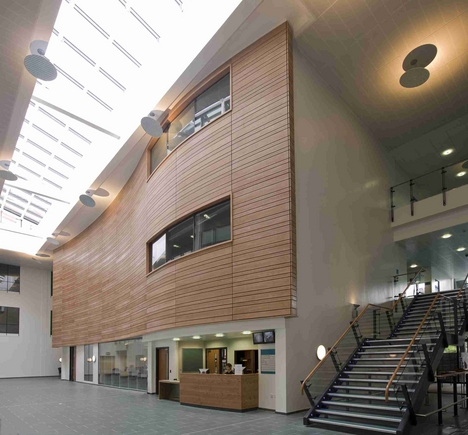
Interior Building Design
Improve Quality of Life With the Latest Building Design Trends
In the 1980s and 1990s, people were worried about lead paint fumes, fluorocarbons, asbestos and other toxic chemicals found in our homes and offices. This fear was so widespread that the news media dubbed it "Sick Building Syndrome." As a result, much attention has been focused on sustainable, energy-efficient, health-promoting building design. Making the necessary adjustments to your home may be as simple as choosing compact fluorescent light bulbs and Energy Star appliances, or it may be as complex as trading in that dated carpet for recycled bamboo flooring.
In the 1980s and 1990s, people were worried about lead paint fumes, fluorocarbons, asbestos and other toxic chemicals found in our homes and offices. This fear was so widespread that the news media dubbed it "Sick Building Syndrome." As a result, much attention has been focused on sustainable, energy-efficient, health-promoting building design. Making the necessary adjustments to your home may be as simple as choosing compact fluorescent light bulbs and Energy Star appliances, or it may be as complex as trading in that dated carpet for recycled bamboo flooring.

Green interior design lighting is important because light sucks up electricity, generates heat and costs us money. A green lighting designer would tell you that compact fluorescent lamps are much more efficient than incandescent lamps, using 80% less energy. "CFLs last 10 times longer than incandescents and normally pay for themselves," explains David Lee, a 23-year lighting designer with The Lighting Source.

Each bulb replaced with a CFL could save you $30 on utility costs, experts say. Of course, since these bulbs contain mercury, disposing of them is just as critical when it comes to green building design. Home Depot stores have orange bins to collect and recycle these bulbs. For those who wish for sunnier lighting color, halogen lights still offer 30-40% energy savings, compared to incandescents, although they are not as good as CFLs.

Many eco-friendly consumers are also looking for green interior design furniture and furnishings too. As you may know, indoor air quality can be affected by mold, moisture, organic compound emissions from paints, and formaldehyde emissions from cabinets and ventilation systems. Some building design materials collect contaminants and dirt as well. When shopping, you will want to avoid phenolic resin derived plastic laminate found on inexpensive furniture.

Make sure your wood products are certified by the Forest Stewardship Council to ensure the harvesters followed sustainable building practices. Wool that has not been treated with moth-proofing chemicals is preferable to polyester. Beware of polyurethane foam padding that contains polybrominated diphenol ethers, which are flame retardants.

The latest building design trends will focus on improving the quality of life and our planet in an affordable way. "Sustainable development allows economic progress and environmental quality to be compatible goals," said Christine Ervin, Department of Energy assistant secretary for energy efficiency and renewable energy. "Communities are finding that sustainable development strategies save taxpayer money, improve the profits of local businesses, and make the community much more livable."
Source:
http://ezinearticles.com/?Improve-Quality-of-Life-With-the-Latest-Building-Design-Trends&id=2100815
Source:
http://ezinearticles.com/?Improve-Quality-of-Life-With-the-Latest-Building-Design-Trends&id=2100815


Interior Building Design

No comments:
Post a Comment
Hi, please feel free to share your comment here.
For example: Which pictures is the best?
Thanks,
Admin